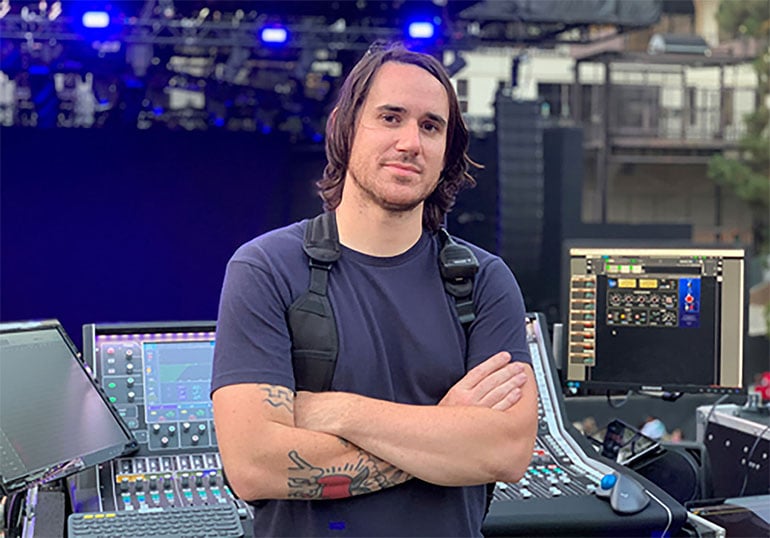Front-of-house engineer Drew Thornton spent several years of his career mixing in what he calls “permanent festival mode” in the Rockwood Music Hall on the lower east side of New York City. With three stages and multiple shows nightly, the venue was like a boot camp for handling fast changeovers and diverse genres. “I mixed just about every genre known to man,” Thornton says, “and I just so happened to get into a loop of mixing female-fronted electropop. It’s kind of my bag now.”
Thornton is currently touring Europe with young artist Billie Eilish, whose breathy, passionate delivery of songs, such as the Number One “Ocean Eyes,” draws wildly excited teenaged crowds. The production is using house-provided P.A.s, while carrying control and drive equipment from sound company Sound Image. Here, Thornton shares details about the tour and the hardware and plug-ins that help him not only keep the artist’s soft voice in front of the mix, but also keep the band in front of a screeching crowd.
Live Design: Who do you have onstage, and what are all of the instruments you need to capture?
Drew Thornton: Counting Billie, it’s a three-piece. Billie sometimes plays uke; and we have the drummer, Andrew Marshall, who plays all the acoustic and electronic drums, and a lot of the samples; and we have Billie’s brother Finn, who produces her music and plays everything else: acoustic guitar, electric guitar, electric bass, synths, sample pad and a Nord piano, and he sings backup. He’s got a lot going on!
LD: What are the pieces of gear that help you manage instrumentation that’s always changing?
DT: My Allen & Heath dLive S5000 console has become indispensable for me, and I can’t say enough good things about it. On the past two or three runs, we have been using automation a lot more, too. I never used to do a lot of automation on the channel strip; I always felt you get the inputs to sound good and you’re there for the set, but here we’re looking at a lot of completely different sounds coming down the same inputs. We have a kick trigger, a stereo kick pad, a snare trigger, and an SPD stereo pair, which has a lot of the remaining sounds coming from the three different automating Roland pads. Finn has a MIDI synth that changes patches from song to song, if not during the song, and that’s all being fired via MIDI timecode.
There’s just a lot going on in each of those tiny worlds, but even so Finn loves to play. I don’t consider them to be a tracks-heavy band, because they’re trying to play everything they can. If Finn can’t cover a part and Andrew can, Andrew will play it even if it came down to being a glockenspiel or bell part!

It’s pretty inspiring that they want to perform as much as they can, but that comes with some caveats, because you’re sending different sounds: That could be a super subby synth sound, or a different kind of cutting synth, a bass patch of an electric bass, or a [Roland] 808 sound. But at the same time, with Billie being as quiet as she is, I have to keep my focus on her during the entire show.
So I’ve worked more on automating compressors and EQs, so all the faders are right where I need them to be. I’m also automating strip design, and then I bring whatever faders I need to my center bank during each scene.
LD: I understand you use a lot of Waves plug-ins on lead vocals. What is in her vocal chain, from mics on down?
DT: For microphones, we’ve been jumping between the [Shure] ULX-D and the Axient, and now we’re also using the V7 from sE. Processing-wise, I have that feeding into a Waves PSE, the Primary Source Enhancer, which gets me a little more gain before feedback.
After the PSE, I’m using Waves’ F6, which is a 6-band dynamic EQ. It sounds great but uses hardly any DSP or latency. Then there’s a Renaissance DeEsser, and the last trick is the X-fdbk plug-in, a feedback eliminator. It’s not a real-time plug in; it’s more of a ring-out plug-in, and it helps get significantly deeper cuts than you would be able to do on a graph, and it tends to leave the gain intact. It only cuts what needs to be cut, and it’s consistent, which I like because I want to be as consistent as possible. I always tune the rig at the same volume every day, and I always ring out the mics the same way. The plan is for us to start carrying our own P.A. this coming October, and that will make it even easier to be consistent when we have the same rig every day.
LD: Do you already have a P.A. rig selected?
DT: I have one in mind. We have three arena shows coming up in October. Sound Image is going to provide a P.A. rig for that little run, and we’ve decided to try a Vue [Audiotechnik] line array rig: AL-12s and VUE HS-221 subwoofers. We tried it in San Diego recently, and it was pretty great. Tim Zigler, who is my systems tech, was out with that system for years with Kendrick Lamar, and he has only good things to say about it.